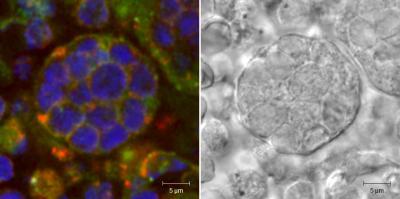Thymic nurse cells were given their name because of their intimate relationship with developing T cells (thymocytes) in the thymus.
Thymic nurse cells have been reported to take as many as 50 thymocytes into their cell body (see thymocytes inside of a thymic nurse cell in photos, the blue dye stains the nuclei of thymocytes inside of a nurse cell). Whether or not thymic nurse cells have the capacity to "internalize" another cell into itself, and the function of this unique biological phenomenon during T cell development is the focus of studies performed by Dr. Guyden at The City College of New York and his colleagues at Tuskegee University. Thymocytes inside of a thymic nurse cell. Credit: Society for Experimental Biology and Medicine
Thymocytes inside of a thymic nurse cell. Credit: Society for Experimental Biology and Medicine
Thymic nurse cells were discovered in 1980. Their existence was heavily debated because many scientists found it difficult to believe that a cell could internalize another cell. In early studies, it was suggested that thymic nurse cells function exclusively in the up-take and removal of non-functional thymocytes from the developmental process.
In a study featured in the June issue of Experimental Biology and Medicine, Dr. Guyden and his colleagues show that thymic nurse cell function is not limited to the removal of non-functional thymocytes, but plays a role in deciding which thymocytes will die, because they will be potentially harmful if they mature, and which will continue to develop into normal T cells.
These results were obtained using a genetically altered mouse system created to study this selection process, which is called MHC restriction. During MHC restriction, all potentially harmful thymocytes must be weeded out (a process called negative selection). The remaining normal subset of thymocytes is induced to mature (a process called positive selection). The genetic alteration in the animals studied results in female mice whose thymocytes undergo positive selection, exclusively, while all thymocytes in male mice are negatively selected. If thymic nurse cells only internalize thymocytes that will be killed and removed, one would expect them to be absent in the female animal (exclusive to positively selected thymocytes that continue development).
However, their results show a significantly larger number of thymic nurse cells containing thymocytes (selected to live) in female mice than in male mice. These data show that thymic nurse cells are not only capable of internalizing thymocytes that have been selected to die, but also possess the capacity to take up thymocytes that have been selected to live via positive selection.